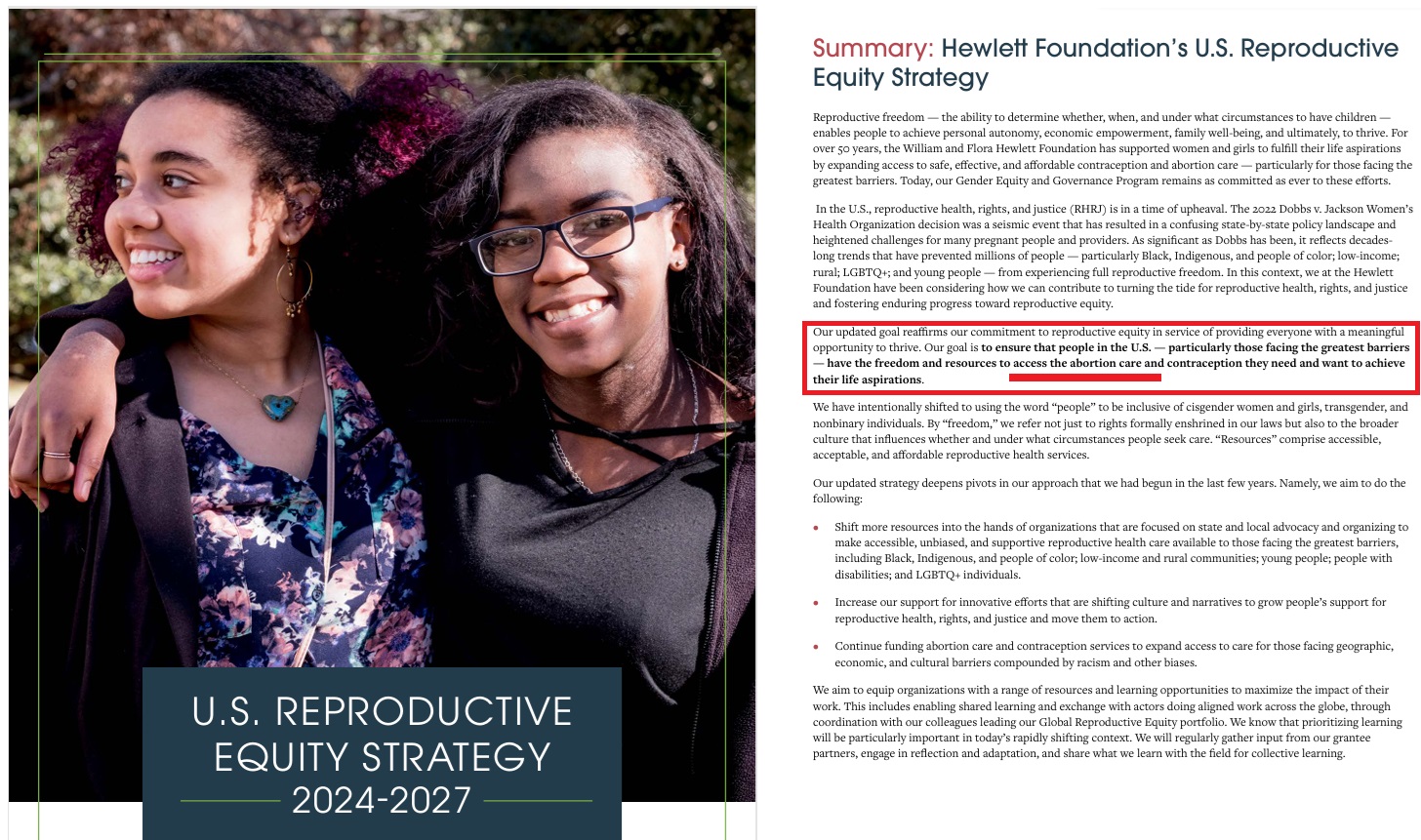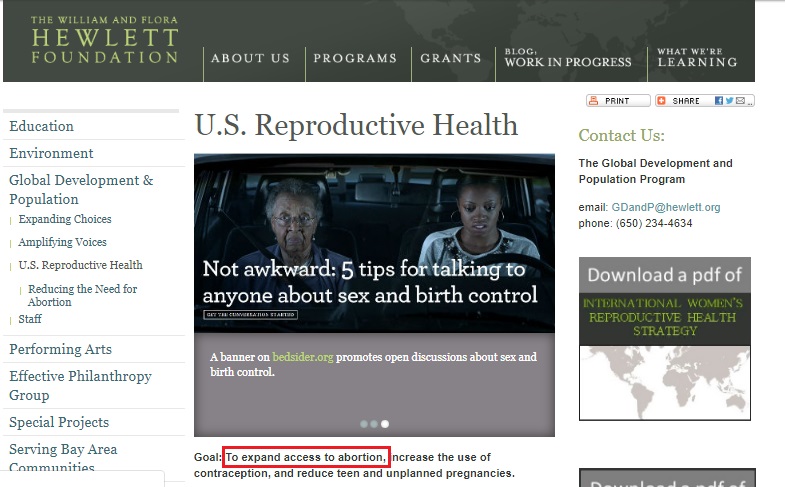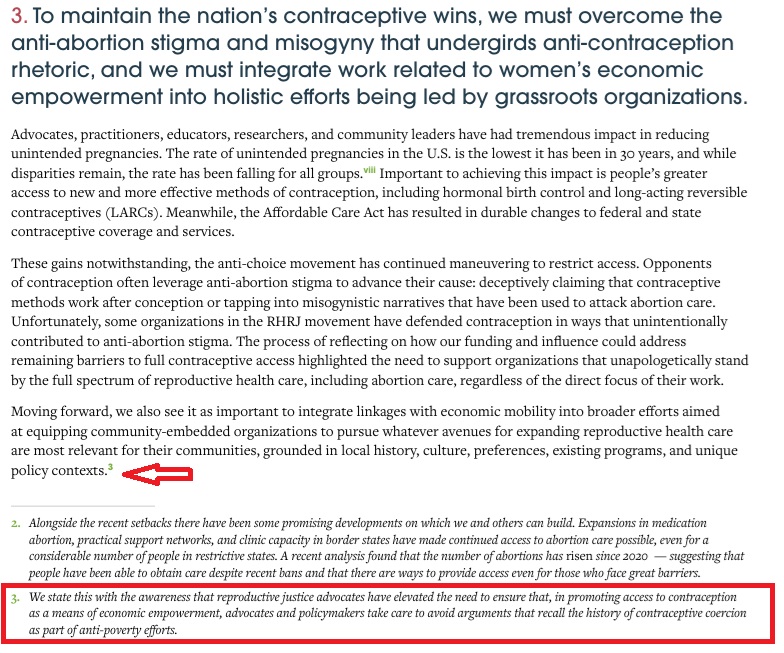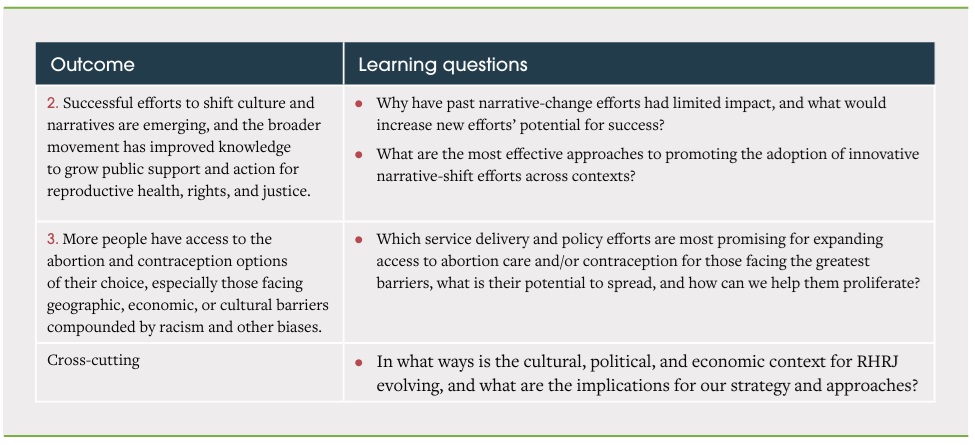The Hewlett Foundation, a long-time abortion philanthropist, has “shifted” its “strategy” since the end of Roe v. Wade. Its new strategic report stated that its goal is to fund abortion organizations and increase “access to medication abortion.”
“Our goal is to ensure that people in the U.S. — particularly those facing the greatest barriers — have the freedom and resources to access the abortion care and contraception they need and want to achieve their life aspirations,” the document claimed.

Hewlett Foundation 2024-27 Strategy to push more abortionProgram Officer in Gender Equity and Governance
What is the Hewlett Foundation?
The William and Flora Hewlett Foundation was founded in 1966 by William R. Hewlett, who co-founded Hewlett-Packard nearly three decades prior in 1939, with longtime friend and partner David Packard. (If that name sounds familiar, that’s because the Packard Foundation is also well known, and a well-known funder of multiple pro-abortion causes.)
“When Bill Hewlett retired from HP’s board of directors in 1987, it was Walter [Hewlett] who took his place. In 1966, at age 23, Walter put up some of his own money to help his parents start the William and Flora Hewlett Foundation. He has served as a trustee ever since. He also is a director of the Packard Humanities Institute,” SFGate.com wrote in 2001.
The Hewlett Foundation is part of a larger cabal of pro-abortion wealthy elites who grant billions to fund abortion, such as Warren Buffett, George Soros, Bill Gates (here), Melinda Gates, and foundations like the Ford Foundation, the Packard Foundation, JPB Foundation, John D. and Catherine T. MacArthur Foundation, Kellogg Foundations, Rockefeller Foundation, Hopewell Fund, Tides Foundation, Wallace Global Fund, Wallace A. Gerbode Foundation, United Nations Population Fund, and others.
As part of the old guard abortion ‘philanthropy’ system, the Hewlett Foundation has funded major abortion organizations like NARAL, Planned Parenthood, and the National Abortion Federation (NAF); it has also funded abortion pill studies and the discredited Turnaway Study.
Funding from Hewlett has been funneled to organizations which attack pro-life groups — Equity Forward, the Center for Reproductive Rights (CFRR), and the Hopewell Fund — and many that expand abortion or commit abortion, including Gynuity Health Projects (GHP), Abortion Care Network (ACN), Carafem, University of California San Francisco (UCSF) and their abortion training arm the Bixby Center for Global Reproductive Health, IBIS Reproductive Health, Advocates for Youth (AFY), the Population Council, DKT International, and the Guttmacher Institute.
Today, Hewlett hides its “mission” to “expand access to abortion” on its “about us” page, but archived pages reveal it is a stated goal:

Hewlett goal to expand abortion funded report on abortion safety
“Originally, the foundation focused primarily on supporting local health providers. Over time, as access to reproductive health care hinged increasingly on the policy environment, we shifted our grantmaking to organizations leading advocacy at the federal level. Most grants went to national legal, advocacy, and policy-focused organizations working to defend Roe v. Wade, to beat back regulatory efforts to restrict it, and to expand and improve access to contraception and supportive health services,” the Hewlett Foundation wrote.
“From 2016 to 2023, our grantmaking focused on an array of efforts to advance an ambitious three-part goal: to (a) prevent unintended pregnancies; (b) ensure access to safe abortion services; and (c) make family planning an integral part of women’s economic empowerment, social mobility, and family stability efforts,” the strategy document stated.
The Foundation’s ‘Reproductive Equity’ Strategy
Entitled the “U.S. Reproductive Equity Strategy 2024-2027” the Hewlett Foundation strategy describes “reproductive freedom” as “the ability to determine whether, when, and under what circumstances to have children — enables people to achieve personal autonomy, economic empowerment, family well-being, and ultimately, to thrive.”
While Hewlett’s strategy contains 50 mentions of “abortion,” it contains no references to pregnancy, maternity, parent, baby or babies, mom or mother, or prenatal, a clear indication of what the actual agenda is here.
It was assembled by Aimee Arrambide, the daughter of a Texas abortionist and a Hewlett Foundation Gender in Equity and Governance Program Officer who previously worked for Avow Texas. Arrambide is also co-editor of the Public Leadership Institute’s “Playbook for Abortion Rights,” which proposed legislation to target pro-life organizations as well as satirical legislation, such as the “Every Sperm is Sacred Act.”
“For over 50 years, the William and Flora Hewlett Foundation has supported women and girls to fulfill their life aspirations by expanding access to… contraception and abortion care — particularly for those facing the greatest barriers. Today, our Gender Equity and Governance Program remains as committed as ever to these efforts,” the Hewlett Foundation wrote.
“In the U.S., reproductive health, rights, and justice (RHRJ) is in a time of upheaval. The 2022 Dobbs v. Jackson Women’s Health Organization decision was a seismic event that has resulted in a confusing state-by-state policy landscape and heightened challenges for many pregnant people and providers,” the Hewlett Foundation wrote. “Although we anticipated Roe’s fall and had already begun shifting our strategy, we recently sought a deeper understanding of the dynamics that led us to where we are today, hoping to derive lessons to make our work more effective going forward.”
The Foundation’s Abortion Goal
The Hewlett Foundation’s 2024-27 strategy is clear that its goal is to increase access to abortion, “Our goal is to ensure that people in the U.S. — particularly those facing the greatest barriers — have the freedom and resources to access the abortion care and contraception they need and want to achieve their life aspirations,” the Foundation’s document reads.
The strategy “aims” to send “resources” to organizations that essentially target minorities.
The Foundation writes that it aims to:
• Shift more resources into the hands of organizations that are focused on state and local advocacy and organizing to make accessible, unbiased, and supportive reproductive health care available to those facing the greatest barriers, including Black, Indigenous, and people of color; low-income and rural communities; young people; people with disabilities; and LGBTQ+ individuals.
• Increase our support for innovative efforts that are shifting culture and narratives to grow people’s support for reproductive health, rights, and justice and move them to action.
• Continue funding abortion care and contraception services to expand access to care for those facing geographic, economic, and cultural barriers compounded by racism and other biases.
“We aim to equip organizations with a range of resources and learning opportunities to maximize the impact of their work. This includes enabling shared learning and exchange with actors doing aligned work across the globe, through coordination with our colleagues leading our Global Reproductive Equity portfolio,” the strategy document stated.
Strategy: ‘Meet immediate needs for abortion’
“We see an opportunity for improved coordination in the distribution of funding across states and in the support available for RHRJ leaders to build strong organizations,” the strategy document claimed. “Dobbs may have escalated the nation’s abortion care crisis, but it also created an opportunity for RHRJ proponents to activate a wider public, find new allies, and pursue innovative strategies. We intend to seize this opening to support the RHRJ movement to achieve and sustain reproductive equity over the long term. We also aim to meet immediate needs for abortion care and contraception among those facing the greatest barriers.”
The Foundation has goals for “Increasing support for organizations that are grounded in communities and leading state and local work is key to turning the tide for abortion care, securing contraception, and achieving an expansive vision for reproductive equity,” “act to urgently ensure [abortion pill] access for millions who face the significant barriers [code for targeting minorities],” and “overcome the anti-abortion stigma and misogyny that undergirds anti-contraception rhetoric, and we must integrate work related to women’s economic empowerment into holistic efforts being led by grassroots organizations.”
That is, so long as Hewlett remains careful to not bring up the coercive history of contraception by “avoid[ing] arguments that recall the history of contraceptive coercion as part of anti-poverty efforts,” the Foundation’s footnote read.

Hewlett Foundation 2024-27 Strategy hide coercive history of contraceptives
Strategies: Wield Power and Influence to Advance Abortion, Shift Cultural Narratives, Expand Telehealth and Mobile Abortion Clinics, Expand Access to Abortion Pills
According to Hewlett’s strategy document, the pro-abortion philanthropic group plans to “To ensure people in the U.S. – particularly those facing the greatest barriers – have the freedom and resources to access the abortion care and contraception they need and want to further their life aspirations.”
To achieve this goal, the Foundation has vowed to “focus over the next few years on advancing three intermediate outcomes.”
Outcome #1: State and local organizations are resourced and are wielding greater power and influence to advance reproductive health, rights, and justice at the local, state, and national levels.
“In addition to investing in individual organizations, it will be important to foster a strong ecosystem by supporting state and local coalitions and networks, and funding the shared infrastructure successful movements require, including robust data and analysis, shared tools, collaborative forums, and dedicated resources for coalition building. We cannot do this alone, of course, and we will seek to engage other funders to support these efforts. We will direct Hewlett’s resources to underfunded states, collect information about the state and local funding landscape, and convene funders to coordinate how we can collectively distribute funding across states to build long-term strength in the RHRJ movement and seize shorter-term opportunities,” the strategy document stated.
Outcome #2: Successful efforts to shift culture and narratives are gaining traction, and the broader movement has improved knowledge to grow public support and action for reproductive health, rights, and justice.
“Shifting culture and narratives can heighten the public’s understanding, empathy, and action orientation, while having the added benefit of improving the social environment in which people seek care. And engaging people through narratives plays a direct role in mobilization efforts. If we want abortion care to be destigmatized and accepted, and if we want contraception to be seen as a normal and safe part of people’s lives, we need new and more effective narratives that will inspire people who are generally supportive of reproductive health care to act. For this work, too, the moment is opportune, given the public’s heightened engagement due to Dobbs and its aftermath,” the Foundation stated. “We will back promising organizations to craft and test new narratives, access larger audiences, and produce knowledge to benefit the entire field.”
Outcome #3: More people have access to the abortion and contraception options of their choice, especially those facing geographic, economic, or cultural barriers compounded by racism and other biases.
“To address today’s inequities in reproductive health care, we need to support practitioners, researchers, and advocates across the country who are identifying new ways of meeting needs for abortion care and contraception — for example, by protecting and expanding telehealth, piloting mobile clinics, developing new accompaniment models, and supporting providers to evolve their service delivery models to maintain clinical infrastructure around the country,” wrote the Foundation.

Hewlett Foundation 2024-27 Strategy to impact abortion narrative
“Inasmuch as the field is in flux and there is much to learn, we intend to fund a range of efforts that show promise but require additional resources to grow. We will also support data collection and research and help disseminate the resulting insights to the broader field for replication and scaling,” the Foundation claimed.
Hewlett Foundation’s strategy seeks to “engage in shared learning and coordinated efforts across our U.S. and Global Reproductive Equity portfolios” and “explore collaborating on investments and grantee learning in emerging areas that bridge our geographies, such as developing new narratives that support reproductive health, rights, and justice; countering misinformation; and increasing access to medication abortion in restrictive environments.”







